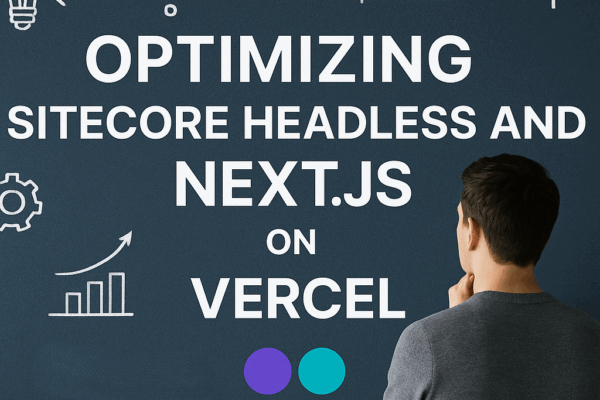Maybe you’ve already made the switch to XM Cloud, or maybe you’re still evaluating it as the answer to all your digital delivery challenges. Spoiler alert: it won’t magically solve everything — but with the right setup and smart optimizations, it can absolutely deliver fast, scalable, and maintainable experiences.
If you’re using Sitecore Headless with Next.js, you’re already building on a modern and flexible foundation. Add in a deployment platform like Vercel, and you’ve got serious power at your fingertips. But unlocking that potential requires knowing where to fine-tune — both at the application and platform level.
Streamline Your Layout and API Payloads
The Sitecore Layout Service is versatile but can return bulky JSON payloads if left unchecked. Clean up your responses by:
-
Removing unused placeholders and renderings
-
Filtering out internal tracking or analytics fields unless explicitly needed
-
Configuring the Layout Service to tailor the response to your frontend needs
If you’re using Sitecore Search or XM Cloud with GraphQL, concise queries will help keep your pages fast and predictable
-
Request only the fields you need
- Use
first:orlimit:to control result size -
Organize queries into reusable fragments for maintainability and performance
Smaller payloads result in faster hydration, quicker time-to-interactive, and lower bandwidth usage — all especially valuable for mobile-heavy audiences.
Use Webhooks for Smarter Publishing (On-demand Revalidation or ODR)
Don’t rely on manual rebuilds or blanket cache clears. XM Cloud supports webhooks on publish, which opens the door to smarter automation:
-
Trigger on-demand ISR revalidation for updated pages
-
Push new content to Edge Config, CDNs, or search indexes
-
Notify external systems (e.g., analytics, commerce, personalization) immediately
It’s the best way to keep content fresh without sacrificing performance or rebuilding the entire site.
Choose the Right Rendering Method: SSR, SSG, or ISR?
Not every page needs to be dynamic, and not every page should be static. Picking the right rendering strategy is critical — especially in a Sitecore headless app where you’re mixing marketing content with personalization and real-time updates.
Here’s how to decide:
Use SSR (Server-Side Rendering) when:
-
The page depends on the user session or request (e.g., personalization, authenticated pages)
-
You’re rendering in preview mode for content authors
Use SSG (Static Site Generation) when:
-
The content rarely changes (e.g., static landing pages or campaigns)
-
You want instant load times and no server cost
Use ISR (Incremental Static Regeneration) when:
-
Content changes periodically, but not per-request
-
You want to combine the speed of static with the freshness of dynamic
Use next/link with Prefetching
If you’re still using regular <a> tags or not thinking about navigation performance, this one’s for you. The next/link component enables fast, client-side routing and automatic prefetching of pages in the background.
Example:
import Link from 'next/link';
<Link href="/products" prefetch={true}>About Us</Link>
-
Use it for all internal links
-
Set
prefetch={true}on high-priority routes -
Check behavior in your browser’s network tab — look for
.jsonpage data being fetched in advance
This alone can make your site feel instantly faster to users.
Optimize Fonts with next/font
Sitecore headless apps don’t include next/font by default, but it’s worth integrating. It allows you to self-host fonts in a performance-optimized way and avoid layout shifts.
Example:
import { Inter } from 'next/font/google';
const inter = Inter({ subsets: ['latin'] });
Apply fonts globally or per-page to improve loading consistency and avoid FOUT (Flash of Unstyled Text). Better fonts = better user experience.
Clean Up Your Codebase
Performance isn’t just about server-side logic — it’s also about keeping your codebase lean and clean.
What to review:
-
Old personalization plugins that are no longer used
-
Middleware that’s too permissive or generic in its matching
-
Outdated multisite logic if you’ve already split into multiple Vercel projects
-
Unused components or fetch logic in shared utilities
Use Vercel performance insights to track slow routes and spot cold starts.
Enable Fluid Compute
Fluid Compute lets Vercel reuse idle time across your serverless functions. That means better performance and lower costs — without any code changes.
To enable it:
-
Go to your Vercel project settings
-
Navigate to Functions
-
Toggle Fluid Compute on
You can monitor the impact under Observability → Logs in your dashboard. It’s a low-effort win. Read more details about Fluid Compute in my previous blog!
Be Selective with Middleware
Next.js middleware is powerful but potentially expensive in performance terms. Use it wisely:
-
Limit middleware to only essential routes
-
Avoid using
fetch()inside middleware — use Edge Config instead -
Replace multisite plugins with separate Vercel projects
-
Audit unused or legacy logic, especially leftover personalization
Track middleware behavior through the Middleware tab in Vercel Logs.
Manage Redirects with Edge Config
For the fastest possible redirects, manage them directly in Vercel using Edge Config. This keeps Sitecore out of the request path and ensures instant resolution at the edge.
- Store all redirect data in Edge Config
- Deploy updates as part of your app or via external config tools
- Avoid real-time fetches from Sitecore for redirect logic
If you’re managing a large volume of redirects, consider using a bloom filter to optimize memory usage. Just note that bloom filters introduce a small delay due to redirect verification.
Conclusion
Optimizing a Sitecore Headless application, especially one deployed on Vercel, is about making dozens of small, smart decisions that add up to big wins in performance, scalability, and developer happiness. Whether it’s pruning your Layout Service output or toggling a setting in your Vercel dashboard, each move brings you closer to a faster, more responsive site.
XM Cloud doesn’t come pre-optimized — but that’s actually a good thing. It gives you the power and flexibility to build the way you want. Just make sure you’re building it right.
Optimization Checklist
Sitecore & XM Cloud
-
Prune Layout Service JSON (remove unused placeholders and fields)
-
Use GraphQL efficiently (limit queries, use fragments)
-
Set up publish webhooks for on-demand rendering or cache purging
Rendering Strategy
-
Use SSR for personalized/authenticated content
-
Use SSG for static pages
-
Use ISR for hybrid performance/freshness
Next.js
-
Replace
<a>withnext/linkand enable prefetching -
Add
next/fontfor consistent and fast font rendering
Vercel
-
Enable Fluid Compute for better serverless efficiency
-
Use middleware only where necessary and avoid fetch inside
-
Use Edge Config for fast redirect handling
-
Monitor logs and performance insights for slow routes and cold starts

